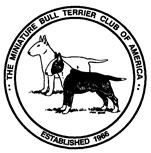|
GENETICS AND
HEALTH COMMITTEE REPORT
LENS LUXATION
PROJECT
I spoke to Liz
Hansen and also to Dr. Johnson in late July concerning progress on the
ongoing Mini Bull research project at the University of Missouri. There has
been no luck as yet in identifying anything in the DNA of luxated dogs to
distinguish them from non-luxated or normal dogs. Dr. Johnson has asked the
AKC Canine Health Foundation for its approval to continue his grant for
another year. However, he is not asking us for any additional funding since
he has not as yet made much progress in finding the genetic marker his team
is seeking.
The sense I got
from speaking with both Liz and Dr. Johnson was that the best hope for
furthering our knowledge about lens luxation in Minis is likely to come from
studies of lens luxation in the Tibetan Terrier and also from the Sealyham
Terrier. For the past several years, the lab at U of Missouri has been
working on other hereditary disorders in Tibetan Terriers. Their data bank
contains blood samples from hundreds of Tibetans and many extended
pedigrees. As you already know, Tibetans also suffer lens luxation, most
likely from the terrier gene, which was accidentally added to the Tibetan
gene pool when an accidental mating occurred many years ago. The story is
that a stray dog thought to be a Tibetan, was declared to be one by a group
of breed authorities, and thereby entered into the British stud book. This
dog, apparently a very handsome fellow, was widely used and produced
numerous equally handsome offspring who were also widely used. When cases of
luxation began to appear in the breed, the luxated dogs all seemed to trace
back the 'stray Tibetan Terrier'. Since lens luxation is considered a
terrier disorder but the Tibetan is not considered a true terrier, it is
thought that there must have been infusion of terrier genes somewhere.
In addition to
having many animals to work with, the Tibetans are not as closely inbred as
are the Mini Bulls. The chances of finding differences between normal and
luxated dogs should be greater.
Other good news is
the interest in our lens luxation project shown by the Sealyham breeders.
Liz told me that in addition to many blood samples, she has an extended
family pedigree with numerous luxated Sealys. Perhaps a break will come from
this direction as, once again it is probably the same abnormal gene at work
in them.
REQUEST FOR SUPPORT
FOR A NEW GRANT
The AKC Canine
Health Foundation has asked our club to financially support a new research
project which has just been approved. The cost would be $2500 per year for
two years. The researcher is focusing on eight breeds, one of which is the
Miniature Bull Terrier. A quote from the Lay Abstract accompanying the
request reads: 'the majority of disorders affecting purebred dogs have no
known counterpart in humans and therefore no candidate gene. However, an
indirect test that screens for strong association of a microsatteline DNA
marker with a disease phenotype can be incorporated in a simple diagnostic
test for carriers of the trait. The ultimate goal of this research is to
design marker panels containing a minimum of 300 microsattelite markers
covering all the linkage groups on chromosomes of the canine genome. The
Veterinary Genetics Laboratory has completed panels containing 100 markers
with known map locations. This project will incorporate at least 200
additional markers map locations that will then represent the entire canine
genome and allow effective screening for linkage of markers to disease
genes."
Today I spoke with
Erika Werne, Grants Administrator at the Health Foundation, to find out more
about ways in which this project will be different from several other genome
mapping projects currently supported by the AKC-CHF. Erika said that this
project is significantly different. She is sending me a copy of the complete
proposal as submitted and eventually approved. I am interested in reasons
why Mini Bulls (and Bull Terriers) are among the eight breeds to be studied.
GENETICS OF CANINE
CANCER
The following is
Dr. Modiano's summary of the talk he gave on cancer genetics and the
importance of "Tumor suppressor genes' at the AKC Health Foundation
conference last October.
Summary

|
